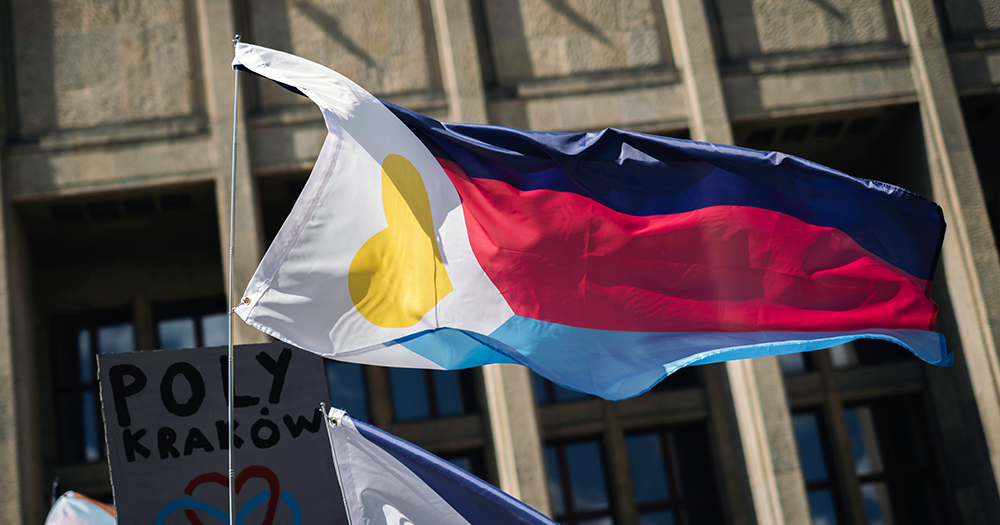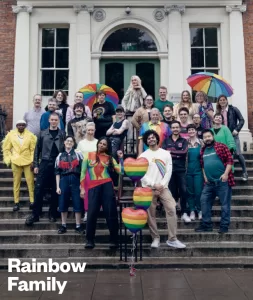Involved in a polyamorous relationship herself, Nicole Lee clears up common misconceptions and breaks down the different types of relationships that fall under the umbrella of polyamory. She invites readers to learn more to combat stigma, judgement and any feelings of shame.
Last weekend, when a friend from my workout group invited me over for dinner, he casually said, “your whole team is invited!” referring to myself, my girlfriend, and my platonic partner. It meant a lot to me because people usually default to inviting a plus one or noting if an event is kid-friendly, but many polyamorous relationships don’t fit into these nuclear family structures.
I consider myself to be a relationship anarchist, which means I challenge conventional ideas about relationship structures and advocate for partnerships that break free from societal norms. For me, romantic relationships are not inherently more important than friendships, and I believe everyone should be free to create their own chosen families outside of the boundaries of marriage and children.
Over the past couple of years, I’ve been learning about different types of polyamorous relationships. I’ve encountered a lot of myths and misinterpretations along the way, so I wanted to offer a broad understanding for anyone who is curious about polyamory, ethical non-monogamy, or queer platonic partnerships.
The word polyamory comes from the Greek word for ‘many’ (poly) and the Latin word for ‘love’ (amor), meaning the practice of engaging in multiple relationships or ‘many loves’ with the knowledge and consent of everyone involved.
Polyamorous people can experience love for more than one person at the same time, and they are open to pursuing multiple relationships simultaneously. These relationships may be sexual, romantic, or platonic in nature. For asexual people, polyamory is one way to establish deep romantic or platonic bonds with partners who may pursue sexual connections outside of that relationship. In fact, the term ‘queer platonic relationships’ originates from asexual and aromantic communities. Co-habitation or marriage is involved, but all polyamorous relationships are built on open communication, mutual understanding, and consent.
While modern society prioritises monogamous relationships, and heteronormative nuclear marriages are centred in the media, this has not always been the case. Polyamory spans cultures and history, including ancient Rome and several indigenous cultures. In fact, according to evolutionary anthropologist Kit Opie, monogamous relationships have only existed for about 1,000 years.
Modern polyamory was first recorded in the 19th and 20th centuries when leaders like British philosopher Bertrand Russell, American utopian socialist Josiah Warren, and the first woman to run for US President, Victoria Woodhull, advocated for alternative relationship structures.
The sexual revolution and free love movements of the 1960s and 1970s popularised non-monogamous relationships, but these efforts are sometimes reduced to the idea of sexual relationships without commitments.
The term ethical non-monogamy (ENM) is somewhat controversial because it’s important to recognise that neither monogamy nor non-monogamy are inherently better or more ethical than the other, but ENM is typically used to differentiate polyamorous relationships from other forms of open relationships which may focus more on casual hookups with little emotional connection.
Consent and open communication are always prioritised in polyamorous dynamics, and polyamorous people tend to seek consensual, honest, and transparent relationships built on emotional trust and connection.
My platonic partner is asexual, and we’ve been married for 11 years, and we both date other people. My girlfriend and I have been together for nearly two years, and we are not seeking romantic or sexual relationships with anyone else. We all live together, and I’m proud of the chosen family we’ve created. I’m very open about my own relationships (check out the Platonic Partner Podcast!), but people still tend to make assumptions and judgments about our dynamic.
One of the biggest misconceptions about polyamory is that it is a free pass to cheat on your partner. Polyamory is built on consent, equality, and emotional intimacy. Dating other people happens based on previously agreed upon terms, but cheating can still occur in polyamorous relationships if someone violates a boundary.
Just like monogamous relationships, polyamorous relationships experience deep love and commitment. They may date long-term, get married, or break-up. And they can also experience jealousya normal human emotion.
Polyamorous people are not sex-obsessed. In fact, many ace people enjoy polyamorous dynamics. People engaging in polyamory tend to be emotionally intelligent and securely attached, since connecting with multiple people requires healthy communication, check-ins, and support.
Because of all the misconceptions, some polyamorous people may feel hesitant to share details or choose to keep their relationships private, but this can create tension when a partner feels invalidated or excluded.
If polyamory is not for you, that’s completely okay. It may mean you are monogamous, which is another beautiful way to practice relationships, but learning about different types of polyamory can help fight harmful stigmas which can lead to misunderstandings, negative attitudes, and discrimination.
Here’s a breakdown of some of the most common types and styles of polyamorous relationships:
Anchor Partners: Stable, long-term partners who provide a sense of grounding or security. Anchor partners may or may not also be primary partners.
Hierarchical Polyamory: Relationships structured with varying degrees of importance, commitment, and boundaries for how far each relationship can progress. These may include primary partners who take priority over other partners.
Kitchen Table Polyamory: Family-oriented dynamic where all members of a polycule are comfortable spending time together in a friendly, communal setting. It emphasises a sense of community among all partners and partners’ partners.
Metamour: The partner of one’s partner, with whom one does not share a direct romantic or sexual relationship. For example, “my partner’s girlfriend is my metamour”
Nesting Partner: A partner with whom you co-habitat. Nesting partners may or may not be primary partners. In non-hierarchical dynamics, all partners are equal even if shared life commitments like home ownership, joint bank accounts, or childcare influence each relationship differently.
Non-hierarchical Polyamory: There is no ranking of partners, all relationships matter equally even if they function differently. Relationships may be long-term or short-term in nature.
Parallel Poly: This is a relationship style where partners maintain separate, independent relationships with minimal interaction between their other partners or metamours. All partners are aware of the other partner(s), but they may never meet.
Polycule: The interconnected network of people involved in a polyamorous relationship structure. This includes everyone who is directly or indirectly connected through each partnership.
Polysaturated: Having as many relationships as one desires at the moment, and recognising you do not have the time or emotional capacity for additional partners.
Polyfidelity: Also known as closed polyamory, a form of polyamory where all members of a polycule are romantically or sexually involved with each other and agree to be exclusive, no one is seeking a new relationship.
Relationship Anarchy: Prioritising caring relationships with varying levels of intimacy that emphasise autonomy, personal freedom, and a rejection of traditional relationship norms. Romantic or sexual relationships are not prioritised over platonic relationships.
Solo Polyamory: A form of polyamory where an individual engages in multiple romantic or sexual relationships without seeking a primary or nesting partner. These individuals prioritise their independence, and tend to resist shared bank accounts, living spaces, and marriage.
Quad: A quad is a polyamorous relationship involving four people, often two sets of couples who are romantically or sexually involved in some capacity.
Triad: A triad is a polyamorous relationship involving three people.
Vee: Comes from the letter V, when one person (the hinge) has two partners. Unlike a triad, the partners of the shared person are not dating each other.
If you feel a resistance to relating to polyamory, it may help to think about these different relationships in the context of different friendships which thrive through different kinds of intimacy, boundaries, and expectations for each friendship. People naturally crave varying levels of alone time, intimacy, and commitment. Polyamory and relationship anarchy invite everyone to decide what kinds of relationships work best for themselves.
If you’re interested in learning more about polyamory, working with a polyamory informed couples therapist is a good place to start. Ruth Crean (they/them) is a neuroaffirming therapist who is passionate about providing Kink Affirming and Polyamory Affirming therapy for individuals and folks seeking ENM guidance.
Ruth says, “Polyamory is not a ‘fix’ for a struggling relationship, it’s a magnifying glass to the existing ways you relate and communicate; it can make people grow and connect in ways they never imagined, but it reveals a lot of the issues that are masked by monogamy. It’s the Marmite of relationship styles, it’s either your thing or it’s really not.”
You can reach Ruth Crean at [email protected].
This story originally appeared in GCN’s June 2024 issue 384. Read the full issue here.
© 2024 GCN (Gay Community News). All rights reserved.
This article was published in the print edition Issue No. 384 (June 1, 2024). Click here to read it now.
Support GCN
GCN is a free, vital resource for Ireland’s LGBTQ+ community since 1988.
GCN is a trading name of National LGBT Federation CLG, a registered charity - Charity Number: 20034580.
GCN relies on the generous support of the community and allies to sustain the crucial work that we do. Producing GCN is costly, and, in an industry which has been hugely impacted by rising costs, we need your support to help sustain and grow this vital resource.
Supporting GCN for as little as €1.99 per month will help us continue our work as Ireland’s free, independent LGBTQ+ media.

